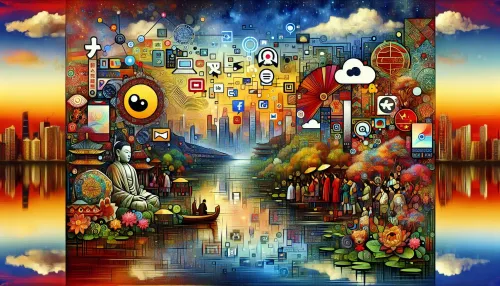Generation Next: How Millennials and Gen Z are Redefining Digital Marketing

In the rapidly evolving landscape of digital marketing, two generations stand out for their profound impact on trends and strategies: Millennials and Generation Z. As digital natives, their comfort with technology, predisposition towards social justice, and unique communication styles are drastically reshaping how brands approach marketing. At ClicksBuzz Blog, we're delving deep into this shift, exploring how these younger demographics are not just influencing but outright redefining digital marketing.
The first step to engaging Millennials and Gen Z effectively is understanding their online behavior. This demographic spends a significant amount of time online, not just consuming content but actively engaging with it. They value authenticity, transparency, and social responsibility from the brands they support. For marketers, this means crafting messages that are genuine and align with broader social causes. Tailoring content to be mobile-friendly is also essential, as smartphones are the primary gateway to the internet for this group.
Understanding the Digital Behavior of Millennials and Gen Z
Influencer marketing has significantly benefitted from the rise of young social media personalities who can sway the purchasing decisions of their followers. However, Millennials and Gen Z are more than just influencers; they're innovators. Platforms like YouTube and TikTok have become launching pads for creative expressions and entrepreneurship. Brands looking to make a mark in the digital domain should consider collaborations that allow these young creators to infuse their innovative ideas into marketing campaigns.
The Role of Influencers and Innovators in Digital Marketing
Social media is not just a pastime for Gen Z — it's a passion. This enthusiasm can be a goldmine for marketers who understand how to channel it effectively. User-generated content campaigns, viral challenges, and interactive polls engage these users much more deeply than traditional ads do. Moreover, by fostering a community around their brand on platforms where Gen Z thrives, companies can mobilize youth creativity as a catalyst for their marketing efforts.
TikTok has emerged as a powerhouse for shaping cultural trends and brand narratives. Its format encourages creativity and can convert any user into a content creator. Forward-thinking brands are using TikTok not only for promotions but also as a channel for storytelling. By participating in trends or creating platform-specific challenges, brands can organically insert themselves into the daily conversations of millions.
Related Article: Digital Marketing Innovations Across Continents
Harnessing Gen Z's Passion for Social Media in Marketing
Millennials and Gen Z are increasingly conscious consumers who favor brands that demonstrate commitment to sustainability and ethical practices. Transparency about supply chains, eco-friendly products, or initiatives that give back to the community resonate deeply with these demographics. In essence, young consumers seek brands that align with their values; hence, marketers need to underscore these aspects in their messaging.
The Impact of TikTok on Brand Narratives and Trends
To truly engage with Millennials and Gen Z, marketers must learn their language — one that's dominated by visuals, emojis, memes, and brevity. Content that gets shared widely among these groups often carries a mix of humor, relatability, and immediacy. Integrate such elements into marketing materials to ensure they resonate more strongly with youthful audiences.
Sustainability and Ethics: Key Factors for Young Consumers
Emerging technologies like virtual reality (VR) are seeing enthusiastic adoption among younger demographics. Brands can capitalize on this trend by integrating VR experiences that offer immersive engagement opportunities — whether through virtual stores, product demonstrations or interactive games. Such innovations not only attract attention but also drive virality among networks of young users.
Gamification in digital marketing leverages elements typically found in games (like points scoring, competition, or rules of play) to drive engagement and participation. For generations raised amidst rapid technological advances, gamified experiences provide both familiarity and fun. Incorporating these elements into apps or websites can significantly enhance the user journey for Millennials and Gen Z consumers.
Creating Engaging Content for the Young Audience
Fintech services are proving incredibly popular among younger generations who value ease of use, personalization, and instant access to financial services. Brands in this space have an opportunity to gain loyalty by offering educational content around financial literacy or tools that simplify wealth management. Collaboration with fintech platforms could also provide non-financial brands with innovative payment solutions appealing to these tech-savvy consumers.
Related Article: Gig Economy Growth: Decoding the Drivers Behind Digital Marketing's New Wave of Work
The Rise of Virtual Reality in Youth Engagement Strategies
As we look towards the future of digital marketing with Millennials and Gen Z at the helm, it's clear that their influence extends beyond consumption patterns to content creation itself. Through blogs like ClicksBuzz Blog which focus on digital trends shaped by these generations, we glimpse how they're transitioning from mere participants in the digital marketplace to becoming its architects. By understanding their preferences, values, and behaviors, brands can not only catch up with today's digital natives but empower them as tomorrow's leaders in creative marketing innovation.
Frequently Asked Questions
Millennials and Gen Z are reshaping digital marketing by prioritizing authenticity, transparency, and social responsibility. Their comfort with technology drives brands to create mobile-friendly, engaging content that resonates with their values, ultimately transforming marketing strategies to align with the expectations of these digital natives.
TikTok has become a crucial platform for brands aiming to connect with younger consumers. Its creative format encourages user-generated content and storytelling, allowing brands to engage authentically. By participating in trends or challenges, companies can effectively insert themselves into conversations that resonate with Gen Z.
Sustainability is vital for Millennials and Gen Z as they prefer brands that demonstrate ethical practices and environmental responsibility. They seek transparency regarding supply chains and eco-friendly initiatives. Marketers must highlight these values in their messaging to build trust and loyalty among these conscious consumers.
Check Out These Related Articles

The Asian Influence in Digital Marketing: Innovations and Best Practices

Empowered Voices: How Youth Advocacy is Shaping Brand Messages

The Gig Revolution in Digital Marketing: How Freelance Work is Reconfiguring Agency Landscapes

